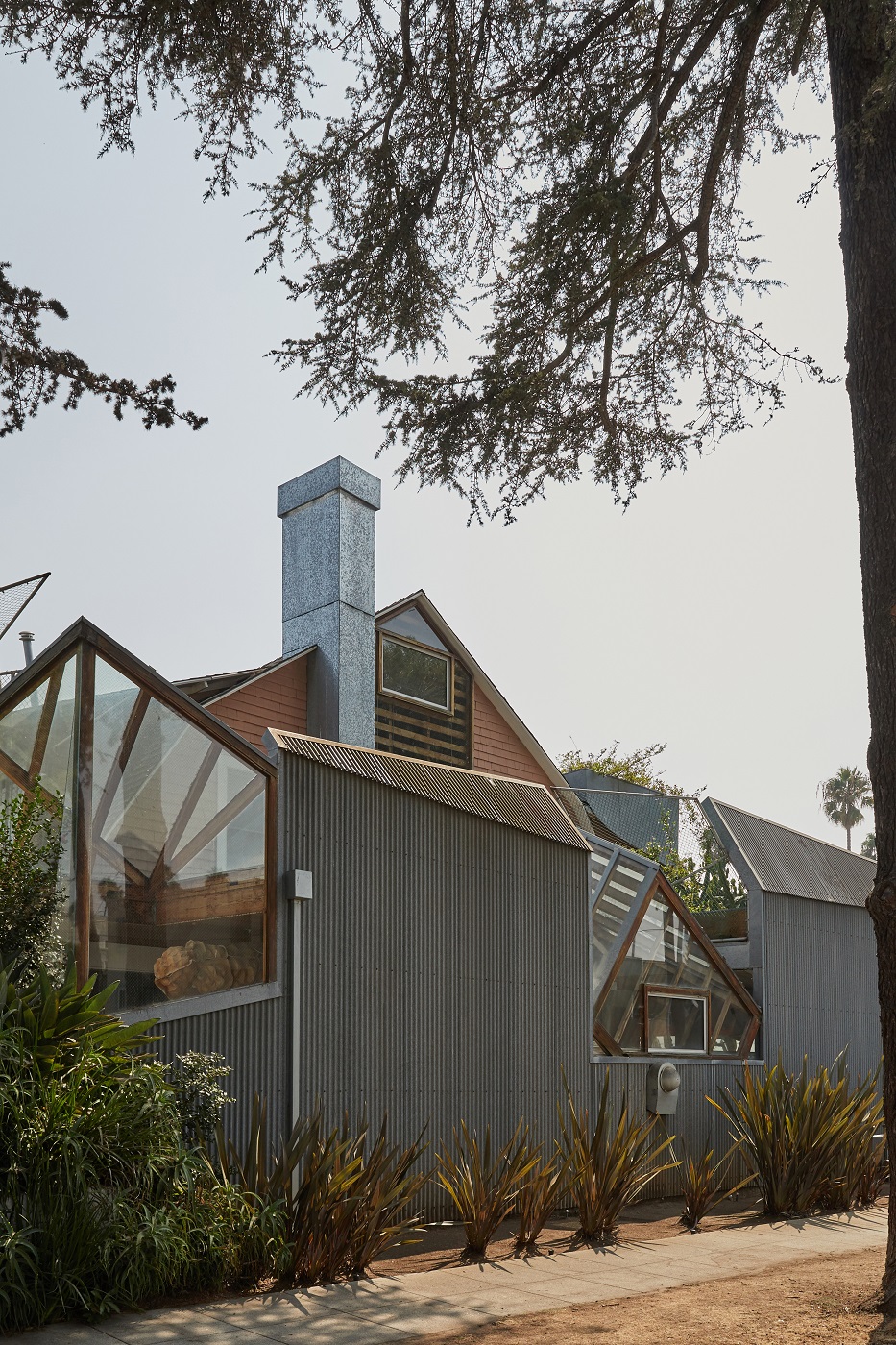Text by Jessica Ritz
Portraits by Nathaniel Wood
Architectural Images by Cody James
Architect Frank Gehry’s work is inextricably connected to Los Angeles. And if L.A. is a city of neighborhoods, as is often said, Gehry’s trajectory and standing as a towering figure in his field can be traced back to Santa Monica and its adjacent communities.
The Toronto-raised Gehry, born Ephraim Owen Goldberg, arrived in L.A. with his family in his late teens in 1947, as the city was hitting its postwar expansionist stride. Soon, his path included driving a delivery truck, studying under ceramic artist Glen Lukens at the University of Southern California and a fateful introduction to architect Raphael Soriano at the modern home Soriano designed for Lukens, followed by military service. Next was a year immersed in city planning at Harvard University’s Graduate School of Design and travels through Europe.
The time away reinforced why Southern California called to Gehry, with its geography, unconventional creative fodder, and burgeoning avant-garde art scene. “Art gives you a sense of freedom,” he told the Los Angeles Times in 1981. “There were rigid rules in architecture, and there don’t need to be.”


Gehry’s early, modest efforts, such as the Danziger Studio and Residence, built for graphic designer Louis Danziger in 1965 on Melrose Avenue near La Brea Avenue, speak to the architectural vernacular of Southern California while deconstructing form and function. The studio’s boxy volumes, with unadorned, solid fronts that do little to engage with the street, contain an expansive working and living environment oriented around an internal courtyard.
“What is important and striking is the way in which this elegantly simple envelope not only reaffirms the continuing validity of the stucco box as Angeleno architecture, but does so in a manner that can stand up to international scrutiny,” wrote architectural critic and historian Reyner Banham in his seminal 1971 book, Los Angeles: The Architecture of Four Ecologies. Less than two miles from the Danziger Studio on Melrose Avenue, Gehry expanded an idiosyncratic yet practical facility for Gemini G.E.L. printing workshop and gallery in the mid-1970s, leaving many of the building materials in raw and expressive states.
Today, Gehry’s influence is apparent both in L.A.’s built environment and among its next wave of design professionals. “He was diversified early on,” observes Ana Henton, an architect who co-founded Still Life Ceramics studios, located in Santa Monica and downtown L.A. “That was a huge inspiration.” The roster of L.A. architects like Henton who honed their skills with Gehry before establishing flourishing practices is indeed extensive, including Benjamin Ball, Edwin Chan, Ali Jevanjee, Colby Mayes, David Montalba, Christopher Mercier, and Gaston Nogues. “I learned a ton, and everybody worked so hard,” Henton adds. “Everyone I was in contact with really gave it their all.”


In 1978, Gehry radically rethought the single-family American home in remodeling his own house in Santa Monica, literally busting through its trim, respectable Dutch Colonial-style confines with chain-link fencing and corrugated exterior additions. (Gehry and his wife, Berta, only recently moved out of this home into another, more polished residence in Santa Monica that their son, Sam, designed collaboratively with them.)
Residential commissions that materialized in the 1980s, notably the Schnabel House in Bel Air, signified the monied class was signing onto Gehry’s program, with more lavish budgets and extensive square footage. But the California Aerospace Museum at Exposition Park—part of L.A.’s civic boosterism leading up to the 1984 Olympics which was eventually folded into the California Science Center—catalyzed new ambitions.
While Gehry’s services were sought by increasingly high-profile institutions and corporations, he remained engaged in local design. He turned a former dairy on Main Street in Santa Monica into Edgemar, a mixed-used development that evokes the romance of European plazas mixed with SoCal irreverence. (One of its original tenants was the Santa Monica Museum of Art.) The Chiat/Day Building in Venice, dubbed the Binoculars Building for the oversized figurative sculpture by Claes Oldenburg and Coosje van Bruggen framing the entrance, became an instant landmark when it was completed in 1991 and is occupied by Google.
That’s the Frank Gehry thing. You’re not so linear and only do one thing. You grab the whole project.
Eva Sobesky
Gehry has attracted his share of critics, too. Not long after Gehry won the Pritzker Prize, architecture’s highest honor, in 1989, writer Mike Davis jabbed that “the Goldwyn Library [in Hollywood] projects the same kind of macho exaggeration as Dirty Harry’s 44 Magnum.” A 2014 opinion piece on tech website Gizmodo declared, “Frank Gehry Is Still the World’s Worst Living Architect.”
Yet Gehry’s billowy, sculptural structures in metropolises from Bilbao, Spain and Abu Dhabi to Paris and downtown L.A. have landed him in the upper echelon of elite architects worldwide. The Walt Disney Concert Hall, the most iconic of Gehry’s hometown projects, has dominated the intersection at Grand Avenue and First Street since its completion in 2003. While it might seem like a career culmination of sorts, Gehry’s accomplishments have continued apace, and at age 91, he isn’t done.
All along, the architect’s wide-ranging curiosities translated to output in multiple mediums. His furniture designs, most recognizably the 1972 cardboard Wiggle chair for Swiss furniture company Vitra and the bentwood Cross Check seating design firm that Knoll began producing in 1990, have become classics. This holistic approach and embracing of gesamtkunstwerk have impacted designers who have passed through firms Frank O. Gehry and Associates and Gehry Partners.


“That’s the Frank Gehry thing. You’re not so linear and only do one thing. You grab the whole project,” explains Venice-based architect Eva Sobesky, who worked with Gehry for 12 years before launching EIS Studio in 2002. Her focus encompasses everything from landscape to architecture to interiors to furniture, and she regularly hires and overlaps with fellow Gehry alumni. Gehry helped her understand that architecture “is all about space that comes in many shapes and sizes,” she notes. “It doesn’t have to just be a building.”
While Gehry’s splashier buildings hold places on archi-tourism bucket lists, public-facing projects infused with his social idealism are most positioned to be valued parts of the Gehry oeuvre. For instance, he renewed his relationship with the L.A. Philharmonic and its music and artistic director, Gustavo Dudamel, in 2018 when Gehry Partners took on a pro-bono project to transform a former 25,000-square-foot bank in Inglewood into an educational and performance space for emerging musical talent.
In addition to his extant physical legacy, which speaks to a cross-section of audiences and purposes, Gehry’s profound influence will continue to be amplified through the colleagues and collaborators he’s inspired over the past 60-plus years.
“People think he is impulsive, but the projects come out of a strong methodology and development,” Sobesky reflects. “I have stayed very true to that process.”


